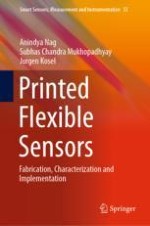This book presents recent advances in the design, fabrication and implementation of flexible printed sensors. It explores a range of materials for developing the electrode and substrate parts of the sensors, on the basis of their electrical and mechanical characteristics. The sensors were processed using laser cutting and 3D printing techniques, and the sensors developed were employed in a number of healthcare, environmental and industrial applications, including: monitoring of physiological movements, respiration, salinity and nitrate measurement, and tactile sensing. The type of sensor selected for each application depended on its dimensions, robustness and sensitivity. The sensors fabricated were also embedded in an IoT-based system, allowing them to be integrated into real-time applications.
